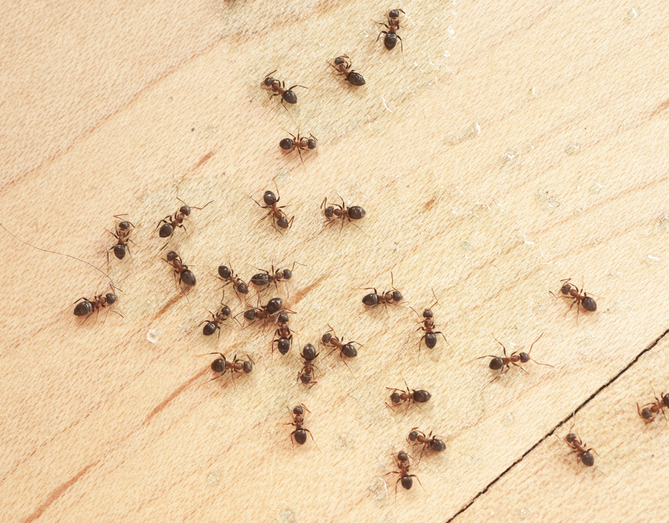How to Differentiate Between Carpenter Ants and Regular Ants: An Orkin Guide
Carpenter Ants vs. Regular Ants
Carpenter ants and regular ants are two distinct species with different characteristics. Carpenter ants are larger, ranging from 1/4 to 1/2 inch long, with a dull red body and black abdomen. They nest in dead wood but do not consume it. In contrast, regular ants, often called “sugar ants,” are smaller, measuring between 1/12 to 1/16 inch long, and can vary in color from light tan to reddish-brown. Regular ants nest both indoors and outdoors, usually near food sources, and are attracted to sweet substances. Recognizing these differences is crucial for effective ant control.
Delving Deeper into Carpenter Ants
Ants are fascinating creatures, playing a crucial role in our ecosystem. However, when they invade our homes, it’s essential to identify them correctly. One of the most common questions we at Orkin receive is how to differentiate between carpenter ants and regular ants. This guide will provide you with the knowledge you need.
Carpenter ants, belonging to the genus Camponotus, are one of the most prominent ant species in many parts of the world. Unlike termites, they don’t eat wood but are known for their wood-boring habits, which can cause structural damage over time. Let’s delve deeper into understanding these fascinating creatures.
Physical Characteristics
- Size – Among the larger species of ants, adult carpenter ants can range from 1/4 to 1/2 inch in length.
- Color – While they predominantly have dull red bodies with black abdomens, their color can vary from black to brown and even reddish or yellowish, depending on the species.
- Distinct Features – One of the defining features of carpenter ants is the evenly convex shape of the top of their thorax. This thorax lacks spines and the attachment between the thorax and abdomen, known as the petiole, has a single flattened segment.

Save $50
on your first recurring service today with code GET50
Habitat and Nesting Behavior
- Preferred Nesting Sites – Carpenter ants typically establish their primary colonies in damp or decaying wood. Common nesting sites include old stumps, dead parts of trees, and even structural timbers in homes.
- Tunneling Behavior – As they carve out their nests, carpenter ants leave behind smooth, clean tunnels in wood. These galleries follow the wood’s grain and can significantly weaken the structural integrity over time.
- Signs of Infestation – One of the most telling signs of a carpenter’s ant infestation is the presence of “frass” – a sawdust-like material. This is the debris they remove as they create their galleries. Piles of frass often indicate nearby nest entrances.

GET A PERSONALIZED QUOTE
To protect your home from pests, click here for a free pest control estimate. Our Orkin Pros will create a personalized pest treatment plan for your home or business
or Call (866) 249-0292
Diet and Foraging
- Omnivorous Diet – While they are known for tunneling through wood, carpenter ants do not consume it. Instead, they have an omnivorous diet, feeding on a variety of foods from plant juices to other insects.
- Foraging Behavior – Carpenter ants are primarily nocturnal, meaning they are most active during the night. They often set out in long trails, guided by pheromones, to gather food and bring it back to the colony.
Life Cycle and Reproduction
- Colony Establishment – A carpenter ant colony starts with a single, winged queen who, after mating, finds a suitable nesting site to lay her eggs.
- Development – From the eggs hatch the legless, grub-like larvae. These larvae undergo several molting stages before pupating and eventually emerging as adult ants.
- Swarming – Mature carpenter ant colonies produce winged male and female ants that swarm, mate, and then establish new colonies. Spotting winged carpenter ants indoors can be a sign of an established nest within the structure.
Carpenter ants, with their unique behaviors and characteristics, are more than just household pests. They play a vital role in the ecosystem by aiding in the decomposition of decaying wood. However, when they pose a threat to our homes, understanding their habits is the first step in effective control. At Orkin, we combine this knowledge with our expertise to provide solutions that protect your home from these industrious ants.
Regular Ants: An In-depth Overview
Ants are among the most common insects that we encounter in our daily lives. While carpenter ants have their unique characteristics and behaviors, regular ants, often referred to as “sugar ants” or “piss ants,” are equally intriguing. Let’s dive deeper into understanding these tiny creatures.
Physical Characteristics
- Size – Regular ants are generally smaller than their carpenter counterparts. They can range in size from 1/12 to 1/16 inch long.
- Color – Their color can vary widely based on the species. Commonly, they are found in shades ranging from light tan to reddish-brown. Some species might even have a darker hue.
- Body Structure – Like all ants, they have a segmented body structure comprising the head, thorax, and abdomen. They also possess antennae, which are vital for communication and navigation.
Habitat and Nesting
- Indoor Nesting – Regular ants can establish colonies inside homes, especially in areas where they have easy access to food. Common indoor nesting sites include wall voids, under appliances, and even within insulation.
- Outdoor Nesting – Outside, these ants might nest under stones, within cracks in pavements, or near plant bases. They prefer moist environments, so they’re often found near water sources.
- Colony Structure – A typical ant colony consists of the queen (or queens), male ants, and worker ants. The queen is responsible for laying eggs, while the worker ants forage for food and maintain the nest.
Diet and Behavior
- Dietary Preferences – Regular ants have a diverse diet. They are particularly attracted to sweet substances, which is why they’re often labeled as “sugar ants.” However, they also consume other insects, plant juices, and even greasy foods.
- Foraging Behavior – These ants are known for their organized foraging trails. They use pheromones to communicate and create pathways to food sources. If you spot a line of ants in your home, they’re likely following a pheromone trail to a food source.
- Activity – While many ant species are diurnal (active during the day), some might be more active during the evening or nighttime.
Prevention and Control
- Sanitation – One of the primary attractions for ants is food. Ensuring that food items are stored properly, cleaning up spills immediately, and regularly taking out the trash can deter ants from invading.
- Sealing Entry Points – Regularly inspect your home for cracks, gaps, and other entry points. Sealing these can prevent ants from entering.
- Regular Inspection – Periodically check common nesting sites, both indoors and outdoors. Early detection can prevent a full-blown infestation.
Regular ants, while small, play a significant role in our ecosystem. They help in decomposition, aerate the soil, and even control pests. However, when they invade our homes, it’s essential to understand their behavior and characteristics to manage them effectively. Remember, knowledge is the first step in coexisting with these tiny marvels of nature.
Orkin’s Solutions for Ant Control
At Orkin, we pride ourselves on our expertise in pest control. If you suspect an ant infestation:
- Call Orkin for a thorough inspection – Our trained professionals can identify the type of ant and recommend the best treatment options.
- Ant Baits – We offer specialized ant baits that target both carpenter and regular ants. These baits are designed to be carried back to the colony, ensuring effective elimination.
- Preventive Measures – We provide guidance on preventive measures to keep ants at bay, ensuring your home remains ant-free.
Frequently Asked Questions
How can I prevent ants from entering my home?
Ants often move indoors looking for better conditions, food, moisture, and shelter.
Can ants cause damage to my home?
Some species, like carpenter ants, can damage wood structures in your home.
Do ants carry diseases?
Yes, some ants can carry and transmit bacterial and fungal pathogens.
How long can ants live?
Worker ants may live up to seven years, while queens can live up to 15 years.
How can I prevent ants from entering my home?
Ensure that your home is sealed properly, avoid leaving food out, and regularly clean up crumbs and spills.
What do ants eat?
Ants eat a variety of foods, including sweets, meats, starches, and liquids.
Are there natural predators for ants?
In their native habitats, ants have natural predators. However, in places like North America, some invasive ant species have few natural enemies.
How can I get professional help for an ant infestation?
Contact Orkin for expert advice and solutions tailored to your specific ant problem.
Conclusion
Differentiating between carpenter ants and regular ants is crucial for effective pest control. Armed with this knowledge, you can take the necessary steps to protect your home. Remember, at the first sign of an ant infestation, call Orkin. We’re here to help every step of the way.
Call to Action
Suspect an ant problem in your home? Don’t wait! Contact Orkin today for a comprehensive inspection and solution. Let us help you reclaim your home from these pesky invaders.

FIND YOUR LOCAL BRANCH
To protect your home from pests, click here for a free pest control estimate. Our Orkin Pros will create a personalized pest treatment plan for your home or business
or Call (866) 249-0292

